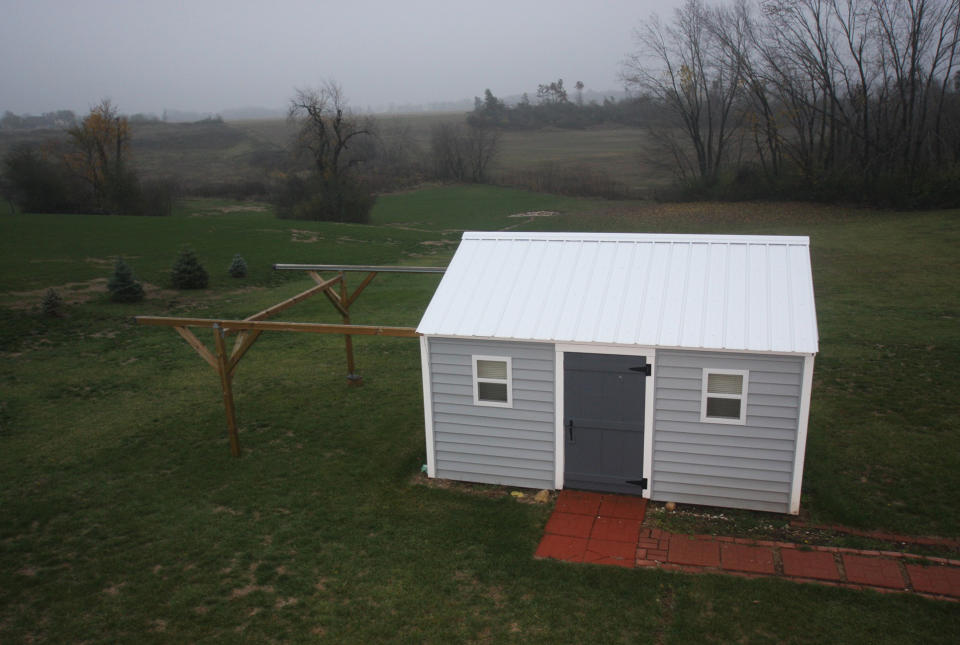Home observatories make star-gazing easier
Regardless of their interest in astronomy, visitors to Chris Krstanovic's home want to look through his telescope.
Krstanovic recently built an observatory at his house in Windham, N.H. Before he added the domed structure, he didn't star-gaze as often as he liked because of the time and effort involved in setting up his telescopes and other equipment.
"It takes you two hours to set up plus two hours to take down. It takes away from your observing time," said the business owner, who developed an interest in astronomy as a kid. "Being out there in the open sky, it's kind of cold. It's miserable."
Now, he can easily search the sky for exoplanets — planets outside the solar system — anytime he wants to. And share his hobby with guests.
"Everybody that comes to our house wants to go in there and look," he said. "Many of my neighbors have young kids. This opens up a whole new field for them. It is a very good way to get young people interested in science."
A growing number of amateur astronomers around the country are installing home observatories to indulge their passion for exploring the night sky, said John Goss of Roanoke, Va., vice president of The Astronomical League, which represents more than 200 astronomical societies.
The cost of equipment has decreased dramatically over the last 20 years, he said. Advances in technology also mean amateurs can buy cameras and viewing equipment once limited to professional observatories. Today, amateurs can buy a telescope and accessory equipment that allows a more detailed look at deep space for about $4,000. A similar set-up might have cost $20,000 two decades ago and wouldn't have been as effective.
Aside from telescopes and cameras, a home observatory must have a roof that opens or retracts, and a stable mount for the telescope. Do-it-yourselfers often construct observatories out of shed-type structures designed so the roof rolls off the building onto support beams. Others buy prefabricated domes and mount them on their homes or other small buildings. It helps to live far from the city lights.
You can set up a home observatory for about $20,000, said Suzy Gurton, education manager at the Astronomical Society of the Pacific, in San Francisco.
She used to see such a project "as the exception. Now, I'd compare it to buying a new car."
And the equipment for viewing and photographing the sky has advanced so much that amateurs, too, are regularly "contributing to science," she said.
"That's the amazing part. The equipment to do scientific observations has become affordable," she said.
Volunteers helped astronomers at Yale University discover a series of small galaxies that could offer insights on how stars are formed. An amateur in Australia is credited with alerting NASA to a spot on Jupiter that scientists believe occurred when a comet or meteor crashed into the planet. Current equipment also allows amateurs to closely study supernovas and offer data on the life cycle of stars.
Krstanovic works with professional astronomers to help measure star spots, which can determine how fast a star rotates.
"You now can have something that if you know how to use it and if you have the right camera, you can do some real science," he said.
He completed his observatory, a 10-by-10-foot structure built on a deck behind his house, about four months ago. Winter viewing is best and he is looking forward to using the new setup in the coming months.
He already often watches the sky remotely from a computer in his house because the observatory is unheated. Telescopes function best when they are the same temperature as the air.
Hobbyists often opt for a home observatory when they acquire so much equipment that it's cumbersome to set it up and take it down, said Jerry Smith, owner of Technical Innovations, a Gaithersburg, Md., company that produces observatory domes for amateurs and professionals. For $20,000, he said, an amateur can create a setup that would have cost about $200,000 a decade ago.
Many of Smith's customers are retirees who have more time to pursue their interest in astronomy. Some clients design their retirement homes to include observatories, and he cites communities in Arizona, Georgia and New Mexico that are intended for amateur astronomers. The developments are in rural areas and have restrictions on outdoor lighting to make star gazing easier.
Scott Jamieson doesn't live in a dedicated astronomy community but he was thinking about his observatory when he chose the location of his home in Eagle, Wis. The recent retiree heads out to the observatory in his backyard about once a week to photograph galaxies and star clusters.
"I chose this location for its darker sky," said Jamieson, who uses an observatory with a roll-off roof. "You can see the whole sky. I enjoy that."



